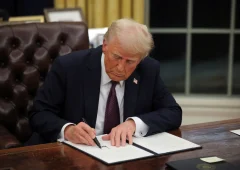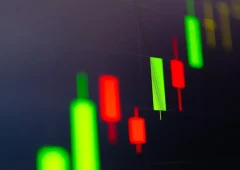Crypto Sector H1 2025 Roundup: Binance Report Shows Institutional Surge and Tech Growth
19.07.2025 11:00 2 min. read Kosta Gushterov
According to Binance Research’s H1 2025 digital asset market report, the total cryptocurrency market value rose by 1.99% year-to-date—signaling cautious optimism following 2024’s explosive 96.2% rally.
The report paints a picture of a maturing market balancing macro risks with institutional momentum and technological progress.
Bitcoin retains dominance amid ETF flows and BTCFi growth
Bitcoin remains the industry’s anchor, gaining 13% in H1 and outperforming most traditional indices. With a market cap exceeding $2 trillion and 65.1% dominance—its highest in four years—BTC continues to attract institutional capital. Spot ETF flows were pivotal, and over 140 companies now hold 848,100 BTC.
Despite slower on-chain activity, BTC’s utility in decentralized finance (BTCFi) surged over 550% year-over-year. Hash rate and network security remain robust, reinforcing confidence in Bitcoin’s long-term fundamentals.
Ethereum leads Layer 1s, while Solana, BNB Chain, and others show strength
Ethereum remained the top Layer 1 platform, supported by the Pectra upgrade and strong institutional inflows. Solana gained traction with high throughput and improved reliability. BNB Chain saw record DEX activity and diversified with memecoins, RWAs, and AI integration. Avalanche expanded in enterprise subnets, Sui doubled its DeFi TVL, Tron remained central to stablecoin transfers, and TON advanced its Telegram integration.
Layer 2 solutions displayed mixed performance. Base and Arbitrum led with sustainable revenue models, while ZK rollups made technical strides but lagged in adoption. Sequencer decentralization and Stage 2 readiness are key areas of focus heading into H2.
DeFi and stablecoins reach new milestones
DeFi adoption surged with a 240% rise in monthly active users year-over-year. TVL held steady at $151.5 billion, while DEXs captured 29% of spot trading volume. Innovations included restaking via EigenLayer and prediction markets through Polymarket-X.
Stablecoins reached a $250 billion market cap, with USDT holding strong and USDC doubling supply. The GENIUS Act in the U.S. and MiCA in Europe boosted regulatory clarity and institutional trust.
Emerging trends and global regulatory divide
Web3’s reach expanded into culture and infrastructure. DeFi merged with TradFi, wallets evolved into super apps, and memecoins drove engagement. Integration of AI (DeFAI) and real-world blockchains (DePIN) highlighted the blending of virtual and physical systems.
Geopolitically, President Trump’s return brought crypto-friendly U.S. policy, while Europe tightened oversight. Asia showed mixed signals, with Hong Kong enabling innovation and Singapore enforcing stricter controls.
Looking ahead, Binance identifies ten key trends to watch in H2 2025, including Bitcoin’s cycle, regulatory frameworks, AI integration, Ethereum scalability, and the evolving competition among Layer 2s.
-
1
U.S. Bank Advises Clients to Drop These Cryptocurrencies
29.06.2025 10:00 2 min. read -
2
Chinese Tech Firms Turn to Crypto for Treasury Diversification
26.06.2025 17:00 1 min. read -
3
FTX Halts Recovery Payments in 49 Countries: Here Is the List
04.07.2025 18:00 2 min. read -
4
What Are the Key Trends in European Consumer Payments for 2024?
29.06.2025 8:00 2 min. read -
5
What Brian Armstrong’s New Stats Reveal About Institutional Crypto Growth
29.06.2025 15:00 2 min. read
Key Crypto Events to Watch in the Next Months
As crypto markets gain momentum heading into the second half of 2025, a series of pivotal regulatory and macroeconomic events are poised to shape sentiment, liquidity, and price action across the space.
Here is Why Stablecoins Are Booming, According to Tether CEO
In a recent interview with Bankless, Tether CEO Paolo Ardoino shed light on the growing adoption of stablecoins like USDT, linking their rise to global economic instability and shifting generational dynamics.
U.S. Dollar Comes Onchain as GENIUS Act Ushers in Digital Era
In a statement that marks a major policy shift, U.S. Treasury Secretary Scott Bessent confirmed that blockchain technologies will play a central role in the future of American payments, with the U.S. dollar officially moving “onchain.”
JPMorgan Lawsuit Threatens Crypto Access and Open Banking Rights
JPMorgan and other major U.S. banks are under fire for a lawsuit aimed at dismantling the Consumer Financial Protection Bureau’s (CFPB) newly established “Open Banking Rule.”
-
1
U.S. Bank Advises Clients to Drop These Cryptocurrencies
29.06.2025 10:00 2 min. read -
2
Chinese Tech Firms Turn to Crypto for Treasury Diversification
26.06.2025 17:00 1 min. read -
3
FTX Halts Recovery Payments in 49 Countries: Here Is the List
04.07.2025 18:00 2 min. read -
4
What Are the Key Trends in European Consumer Payments for 2024?
29.06.2025 8:00 2 min. read -
5
What Brian Armstrong’s New Stats Reveal About Institutional Crypto Growth
29.06.2025 15:00 2 min. read



